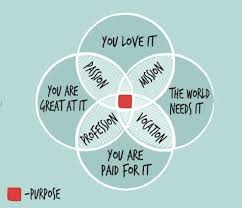Last time, in Part 1, we discussed the importance of having a purpose for your life, and we related it to many of the same reasons that a company has a vision. Just as an organization’s vision acts as a statement of potential and a description of what it wants to become, a personal purpose statement gives shape and direction to your life. Conversely, not knowing where you want to go or how to get there is not a very effective way to live purposefully.
Now that you understand how important it is to live purposefully, you’ll want to get started, so here are some steps to get you moving in the right direction.
Step 1: Take inventory and assess where you are currently. What are your strengths? What might be holding you back? In Jim Collins’ book, Good to Great, he discusses The Hedgehog Concept as the area where a company should focus based on a deep understanding of three intersecting circles: 1) what it can be the best in the world at, 2) what it is deeply passionate about, and 3) what economic denominator best drives its economic engine. So how does this concept apply to your life? Ask yourself a set of similar questions: 1) what are you great at (what are your unique talents), 2) what do you love to do, and 3) how can you earn money (make a living)? Really take some time to think about this and write down your responses. Wouldn’t it be great if you could spend a larger amount of your time in the space occupied by your answers to these three questions? Once you have identified the intersection (overlap) of these three areas, you’re ready for Step 2.
Step 2: Determine your purpose. Developing a personal purpose statement gives shape and direction to your life. Make certain that your purpose statement is consistent with what you identified in Step 1. Also, at least at first, keep it as simple as possible. You can always add more detail as you progress. For example, try merely filling in the blanks using a simple statement like this one: “I exist to serve by ____ing _________________.” My purpose statement is: “I exist to serve by helping others reach more of their potential.” This umbrella statement governs how I strive to live my life, both personally and professionally, and yours should do the same. Once you have completed Step 2, you’re ready for Step 3.
Step 3: Identify goals associated with your purpose. What do you need to be working on and doing to help you live out your purpose? Do you need education and training? How is your attitude and self-confidence? Are your relationships where they should be? Are you in good physical condition? Are you motivated and continually challenging yourself? Identify the areas in which you need to improve and write out SMART goals to help you get there. With your goals identified, you’re ready for Step 4.
Step 4: Start executing. Why wait? Yes, it takes time, energy, motivation, and possibly money or other resources. You will likely need to confront some fears and areas of discomfort as well. But if your goals are really important to you, then there’s no time like the present to work on them. Procrastination is a goal-killer. William James said, “Procrastination is attitude’s natural assassin. There’s nothing so fatiguing as an uncompleted task.” So get started today.
Finally, in Step 5, it is critical to continually assess how you’re doing against your goals and to make corrections and adjustments along the way. “Life happens”, so the plans you put in place now may not be exactly what you need six months from now, so plan your work and work your plan. And don’t let your goals and plans go stale…keep them fresh and ever-changing based on what’s going on in your life. You’ll be so satisfied as you achieve the goals that allow you to fulfill your purpose. We all have goals and ambitions in life, but too often we let our dreams slide by without taking action. Time to get started.

